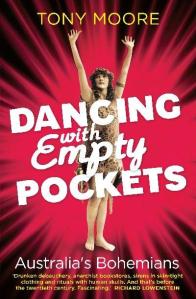2012, 351 p
Thanks to the vagaries of the hold system at my library, I read this book shortly after reading Melissa Bellanta’s book Larrikins: A History. As with Bellanta’s book, this one too was adorned with the label on the spine describing it as ‘Travel and Culture’, and both books explored in different but complementary ways the appropriation of the term ‘larrikin’. Bellanta’s book is much more accessible and person-based than this one, which is based on the author’s doctoral research, more heavily freighted with theory and hence requires more concentration. But it’s worth it.
Moore looks at bohemianism as a mindset and abstract phenomenon, and locates its starting point with Henri Murger’s 1851 book Scenes de la View de Boheme , based on the author’s own lost youth amongst the unconventional and impoverished aspiring writes, painters, poets and philosophers of the Latin Quarter of Paris.
Moore commences his study of Australian Bohemianism with Marcus Clarke, who is better known today for his book For the Term of his Natural Life than for his voluminous press writings or lifestyle. Clarke adopted the stance of the urban flaneur, strolling observing and reporting about town, playing the dandy, joining mock clubs and, descending into ‘lower bohemia’ for brief excursions. Clarke preferred the city to the bush, but this was reversed by the ‘bush bards and artist heroes’- the Heidelberg School of Artists, Lawson, Dennis, Lindsay et al- who identified with and drew upon the culture of both town and country workers. Here is the crossover with Bellanta’s work where Lawson and Dennis romanticized and sentimentalized the urban, delinquent larrikin culture, and identified themselves as having a softer, cosier ‘larrikin streak’. Moore explores the overlap between bohemianism and radical politics at the turn of the twentieth century, a theme picked up again in his analysis of the Cold War anarchists of the Sydney Push, and its mainstreaming with the victory of the Whitlam government. Yet interweaving, and sometimes challenging, this more ‘intellectual’ political seriousness was the carnivalesque, performance aspect of Bohemia, present from the start but most notable during the 1920s Jazz age and again in the expression and resistance to the modernist avant-gardes like the Angry Penguins.
The book is arranged chronologically, and switches its focus mainly between Sydney and Melbourne, and particular suburbs and places within these cities- Darlinghurst, King’s Cross, Fitzroy, Eltham, my own Heidelberg. Structurally, the chapters take in 20 or 30 year thematic bites, with single chapters devoted to the 1920s and the 1950s. However, the period of the 1960s to 1980s is treated to three chapters, where he discusses the commodification of bohemianism, the politics leading up to Whitlam, and the capture and contribution of bohemians in the exploration and dissemination of the “Australian identity”. The book closes with a chapter dealing with 1980-2012 which argues the continuation of the bohemian tradition through the counter-culture, punk and pomo.
His focus is mainly on artists and writers (journalists rather more than novelists) and I found myself wondering about earlier musicians and theatrical performers, although these do get a look in with Dulcie Deamer in the 1920s and even more so from 1970s on. There is a huge cast of characters here- the index really doesn’t do it justice- but at times this felt a little like a roll-call.
He argues that the connections, transmissions and patterns of living implicit in Bohemianism are often invisible to the historical actors themselves, but apparent to the historian who takes a long term perspective (p. 344). Indeed, bohemianism often manifests as a conscious push against what immediately came before it, and conversely, bohemians tend to see themselves in retrospect as the last ‘authentic’ bohemians.
It was common for Australian bohemian artists and writers, once established and grown older, to recycle the bohemianism of their youth as nostalgia in memoirs, journalism, exhibitions, television documentaries and even semi-autobiographical films. Across the generations they close down the possibility of tradition by denying the credentials and credibility of young artists who came after them. (p. 345)
Although I am in no sense WHATEVER a bohemian, perhaps I too am doing this because I found the last chapter of this book the least satisfying and often found myself thinking “But they’re not real Bohemians!” In this regard, Moore was right, I think, to separate out his analysis of the 1960s-80s to explore the commodification of bohemianism because I think that it marked a qualitative change from the ongoing ambivalence that had always existed between rebellion and the need to earn money to eat. Hence, I found myself puzzling over some of the current mass-media ‘personalities’ he included within the bohemian tradition- the Masters Apprentices, The Chaser, Midnight Oil- and distrusting somewhat his inclusion of his own contribution to bohemia. Was the last chapter perhaps more a manifesto, a claim for a stake in the bohemian paddock, rather than a historical analysis? Perhaps it’s just that I feel uncomfortable having my own present historicized?
Just an aside- a fascinating interview with Dulcie Deamer (complete with cupid’s bow lips) from the 1960s here. In fact the whole collection of You Tube videos Stations of the X is engrossing.


Thanks for that review. I bought this book some months ago but didn’t read it yet, mum’s reading it now. I look forward to getting stuck into it & learning more abt Australia’s unique history.
Pingback: Bohemian Melbourne exhibition | The Resident Judge of Port Phillip
Pingback: Six Degrees of Separation: from ‘Normal People’ to…. | The Resident Judge of Port Phillip